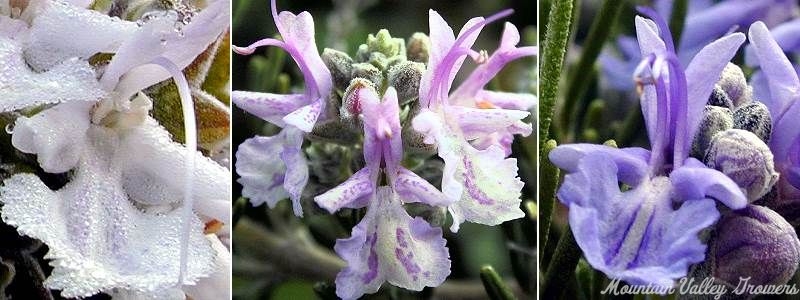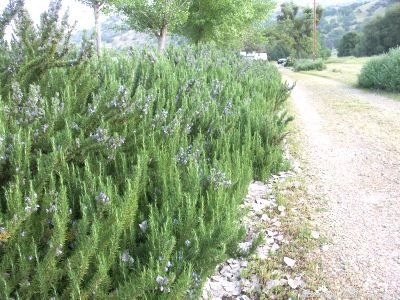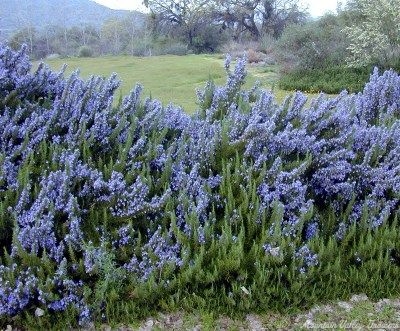The Many Shades of Rosemary!

Rosemary: Black Gold, Herbal Tea
Trim Rosemary for any length of time without gloves and your fingers become covered with a sticky black resin. Actually, it is oil. And, for lovers of Rosemary this oil is as good as gold. It is this black gold that gives Rosemary its aromatic, flavorful, and healthful properties.
With over a thousand different kinds of herbs and perennials available to us here at Mountain Valley Growers it might seem difficult to choose a favorite, but for me it is definitely Rosemary. Disappointed? If you knew Rosemary the way I know Rosemary, you wouldn’t be. The uses for Rosemary are endless. It’s versatility and ruggedness make it the perfect California landscape scapegoat. In cooking, Rosemary is perfect for everything from soup to dessert. And, new health benefits of Rosemary are being brought to light as scientists research the chemical constituents found in Rosemary’s black gold.
Landscaping With Rosemary Plants
Our experience with using Rosemary in the landscape is extensive. It was one of the first plants purchased for the nursery. Planted over 30 years ago from a three-inch pot, the original Rosemary plant now measures almost five feet high and twenty plus feet wide. This one small Rosemary plant became the parent to many others that eventually were planted with it and they, too, quickly became a permanent part of our landscape. Who knows, if we watered them more often they might even be bigger, but these Rosemary plants receive only 2 or 3 deep waterings in the summer. Summers here run about 105 degrees. One summer, this planting of Rosemary was watered only once. While the Rosemary plants did suffer from this abuse, losing several branches in their struggle for survival, several weeks after watering, the plants were healthy and green once again. Rosemary lets you know when it is critically dry by turning yellow green. Chances are even under this extreme stress the Rosemary would not die completely.

Later after the original planting was several years old, we planted our three hundred foot losing driveway at Mountain Valley Growers with more three-inch pots of Rosemary. In the beginning, we wanted the Rosemary on the driveway to form a formal hedge. Every two years the Rosemary plants were suppose to be pruned to their most upright spires. All the undergrowth was to be removed, giving the appearance that the plant just touches the ground. They were pruned this way twice over four years. Removing the sprawling horizontal growth forced more of the plant to grow upright. This formed a wall about three feet high, and the overall appearance became a more solid display of color because the stems are standing together rather than splayed in all directions. However, as time passed and the Rosemary became wider and wider, the pruning effort became too labor intensive and the Rosemary plants were allowed to naturalize. This mass planting is now going on its 34thth year. Now most of the bushes are 3 to 5 feet tall and and many reach 20 feet wide. The Rosemary stems have touched the ground and rooted in hundreds of spaces. They root like this during the wet months and survive with minimum water throughout the summer.

The dark blue flower of our upright Rosemary provides a rich hued mural of blue for many weeks from late fall through early spring. Visitors are often very surprised to discover the plant they are so taken with is Rosemary. Even though many have never grown Rosemary it seems to conjure up some boring picture in their mind. Sort of like never having tasted turnips but innately knowing they are not going to be first choice for dinner tonight. Maybe, this misconception comes from viewing poorly maintained parking lot plantings, often butchered by electric trimmers or driven over by some careless motorist. Perhaps, our tall regal variety of Rosemary is not readily available at the nursery where they shop. Whatever the reason, attitudes toward Rosemary change when our Rosemary driveway is in bloom.
Growing Rosemary Plants
It is tempting to say there aren’t any rules for Rosemary. It is that easy to grow. Like most Mediterranean plants, Rosemary likes to be high and dry. When planting, choose a location with all day sun and a soil rich in organic compost that drains well. If you have wet summers, try raising your Rosemary plants up off the ground, which will help to reduce humidity and increase drainage. Also, don’t crowd your Rosemary plants. With a few exceptions they are large plants and need space. This is especially important with humid summers, because it allows air to move more freely around the plant. Soil rich in organic matter and free of chemicals, should never need fertilizer. If your Rosemary is already planted and you want to improve the soil, layer compost three to four inches around the base of the Rosemary plant and do it often. Very small plants should not be mulched right up to their bases; a three inch air space of bare ground around the little Rosemary plant will keep it from becoming composted. If you spray no harmful chemicals and use only organic fertilizers, the critters at ground level and below will take your compost to the Rosemary plant’s roots and nourish the plants and the soil.
Rosemary plants can be left to grow without pruning which provides a wild naturalized look or they can be pruned to almost any shape. In fact, Rosemary is often used to make topiaries. Be sure to prune your Rosemary plants right after they have bloomed. As new growth occurs, flower buds for the next year are already being set. Late season pruning of Rosemary stems will cause a decrease in the number of flowers. As with any plant, dead stems or stems that are in your way, can be pruned at anytime. We have pruned Rosemary in almost every season with no detriment to the Rosemary plant itself (other than the decrease in bloom mentioned above).
If Rosemary has an Achilles heel, it would be temperature. Ours have done well as temperatures plunge into the teens and even for a brief time at 5 degrees. Most Rosemary varieties are rated for zone 8 which has a maximum low of 10 degrees. Lucky for many colder locations there are Arp Rosemary and Madeline Hill Rosemary which are rated for a maximum low of minus 15.
Where the winters are below minus 15 either bring your Rosemary in the house or greenhouse or treat it as an annual. If you want to over winter your Rosemary plants in the house, grow them as container plants outside after danger of frost and then bring them in before temperatures go below 15. Rosemary planted in containers can get colder than Rosemary planted in the ground because the ground has a built in temperature buffer.
Container grown Rosemary should be planted in a good potting mix with sufficient texture to allow large air spaces in the soil. Adding 25 to 30 percent large size perlite and an all purpose organic fertilizer to the soil mix at planting is preferred. A three-inch pot of Rosemary should be placed into at least a gallon of soil. We do not recommend combining Rosemary with other herbs unless you have a really big pot. Planting perennial herbs together can make it difficult to repot when the plants become root bound.
Each spring, after danger of frost, move your Rosemary to a larger pot or root prune and refill the container with fresh soil. Bring your Rosemary pot in before the first frost and give it as much light as possible. Be careful not to let it get too close to ice cold window panes. Fluorescent lighting can be used by placing the lights about three inches above the tops of the Rosemary plants and leaving the lights on for about 14 hours. Watch the water. Only water when the soil is dry. Use either a water meter or a pencil to test the soil before you water. Insert your pencil as far into the soil near the Rosemary roots as it will go. If it comes out with just a few crumbs, then go ahead and water. Don’t let the pot sit in a saucer with water and use room temperature water to avoid shocking the plant. In the spring after danger of frost has passed, move your pot of Rosemary outside by gradually exposing it to the outdoors. Place the container in a sunny location and give it a few more hours of sunlight each day.
Varieties of Rosemary Plants and Their Uses
There are so many kinds of Rosemary available now that choosing one might seem daunting. But, in fact many of the named varieties are very similar to each other. We have chosen to offer Rosemary varieties that are very different from each other.
Upright Rosemary does not have to be pruned at all. It flows outward forming a perfect circle that can measure between six to eight feet (or more over time) in diameter and is two feet to five feet tall. This produces a very pleasing natural look, requires no maintenance at all and makes the perfect companion for the native landscape. Low water requirements mean low weed germination during the dry months. Because this Rosemary grows rampantly to cover the ground, it smothers all weeds under it. Eight feet of weed cover from one Rosemary plant is a lot of value for your dollar. Sprawling branches and a tough, extensive root system are also ideal for hillside retention. Mass planting can fill a large expanse with rich colors. While all Rosemary varieties can be used for cooking, this Rosemary is particularly nice because of its large leaves and their high oil content.
Creeping or Trailing Rosemary is a tall ground cover that can cover eight to ten feet in diameter in a very short period of time. It can also trail down eight to ten feet. It makes a most beautiful planter box for a second story balcony. It falls all the way to the ground and is covered with pale blue flowers. Or, planted on a hot southern facing wall this man made waterfall is a welcome relief from the heat. Creeping Rosemary, also known as Santa Barbara Trailing Rosemary, gets a little taller each year as it grows over older branches.
Pine Scented Rosemary has finely textured leaves that are easily chopped up. This plus an excellent flavor make this Rosemary the variety many chefs prefer. Pine Scented Rosemary is a different species than our other Rosemary plants and it shows. Other Rosemary varieties have such coarse leaves that using them fresh can be a problem. Even chopped fine they are very tough, but this Rosemary’s leaves are soft, like cilantro or parsley which make it more suitable for fresh use. A very pretty plant in the landscape, Pine Scented Rosemary is a soft sea green that grows to about three to four feet high by about six or more feet wide, depending on how it is pruned.
Arp Rosemary is one of the Rosemary varieties to choose if you live where winter temperatures are frequently in the teens or less. Discovered on a cold snowy day by veteran herb pioneer Madaline Hill in the Texas town of Arp, this Rosemary has survived several winters in the Case Western University Botanic Garden in Cleveland, Ohio, where they must take their other kinds of Rosemary in for the winter.
Madalene Hill Rosemary is also a cold hardy Rosemary. Both of these are rated to survive minus 15 degrees once they are established. And, both are erect, growing to about three feet tall. Their flowers are a light blue.
Pink Rosemary, our rarest Rosemary, has the thinnest leaves of all our Rosmarinus officinalis plants. Gracefully curved branches are punctuated by short spires that rise randomly like exclamation marks. Even though the flower color is pale, there are so many flowers that they combine and provide a respectable cloud of pink, especially when viewed at a distance. Growing quickly to two feet this Pink Rosemary can be enjoyed in its natural whirlwind state or pruned into a hedge. Pink Rosemary’s small narrow leaves are flavorful but because they are small it is not the best choice if you want to do a lot of cooking.
White Rosemary is visually different. This is a beautiful very erect Rosemary plant with fat succulent leaves and white flowers that have just a spot of blue in the throat. The branches of White Rosemary are reminiscent of candelabras and give the plant an open and airy look.
Golden Rain Rosemary is a smaller rosemary with light blue flowers and spring golden foliage. It can brighten a semi-shady spot or offer an interesting specimen in a golden garden. The golden hue turns darker green over summer and returns with cooler weather.
Blue Boy Rosemary is the smallest of all the Rosemary varieties. Small leaves and little light blue pearls for flowers makes Blue Boy Rosemary a good choice for a container or near the front of the garden. Blue Boy Rosemary grows very slowly but it will eventually reach two feet wide or more and about two feet high. It can be used for cooking but because the needles are so small it will take several stems to equal one large stem of a regularly sized Rosemary.
Spice Islands Rosemary has thick juicy looking leaves and very upright growth with a nice dark blue flower. It is perfect to use as a barbecue skewer. Spice Islands Rosemary has become one of our favorites in the garden and in the kitchen.
Cooking With Rosemary
Wafting fragrance emitted from Rosemary plants on a hot sultry day can cool and refresh. The sound of the bees busily working the Rosemary flowers is music to our freeway tired ears. Snapping a few branches and winding them in a loose wreath we take the herb into the kitchen to contemplate the possibilities. No matter how much we enjoy Rosemary in the garden, Rosemary in the kitchen is what it is all about. Cooking with Rosemary is a true delight. As it flavors our food, Rosemary perfumes our home. And while some prefer to use Rosemary dried, fresh is best. Any Rosemary can be used for cooking; we prefer our Upright Rosemary for both fresh and dried use, our Pine Scented Rosemary for fresh use and Spice Islands for providing lots to dry in each fat leaf.
A favorite dish for a cold winter day Red Stew with Rosemary was served many years ago by an excellent cook who included meat in his recipe. Over the years it has evolved into a vegetable stew. This makes a wonderful lunch served with fresh sourdough bread or an excellent side dish for pot roast or even hamburgers.
Red Stew with Rosemary
A favorite dish for a cold winter day this was served many years ago by an excellent cook who included meat in his recipe. Over the years it has evolved into a vegetable stew. This makes a wonderful lunch served with fresh sourdough bread or an excellent side dish for pot roast or even hamburgers.
- 3 or 4 large potatoes washed and cut into chunks
- 5 or 6 large carrots washed and cut into chunks
- 1/4 teaspoon salt
- 1/4 cup soft shortening
- 1/4 cup soft butter
- 3/4 cup granulated sugar
- 1 egg
- 3 tbsp milk
- 1/2 cup chopped citron
- 1/2 cup currants or raisins
- Granulated sugar
- 1 egg white, slightly beaten
- 2-15 ounce cans tomato sauce
- 2-15 ounce cans stewed tomatoes
- Salt and Pepper to taste
- 2-8 inch Sprigs Rosemary
Cook carrots, sauce and tomatoes over low heat for about an hour. Add potatoes and rosemary and cook over low heat until the vegetables are tender, about another hour. The process can be speeded up by increasing the heat and both vegetables can be added at the same time. Add the rosemary during the last half hour of cooking. It also works well in a crockpot. Just add the rosemary during the last hour.
Barbecue Potatoes with Rosemary
And, if the season is summer, then throw your potatoes in a zippered bag with a little olive oil and Rosemary. Shake well and wrap in tinfoil. Toss on the barbecue and enjoy.
Rosemary is a good barbecue herb because of its high essential oil content. Tie some Rosemary twigs together and brush your barbecue or marinade on with your rosemary brush and then throw the brush into the fire. Or, cut nice long stems and strip the leaves off and use the stems for shish kabob spears.
Which Rosemary will you choose?
If you grow indoors and want to cook with your Rosemary, choose our Standard Upright Rosemary or Pine Scented Rosemary. Have a little window box for summer herbs? Pick Blue Boy or Golden Rain Rosemary. Dying to try a topiary? Choose Santa Barbara Trailing Rosemary for single line frames like hearts and circles and Standard Upright Rosemary for fill in shapes like balls or trees. Covering a hillside or wide open space? Santa Barbara Trailing Rosemary grows wide and lower. No matter which variety of Rosemary you choose you will be rewarded with rich aromas, flavors and colors. Black Gold.
